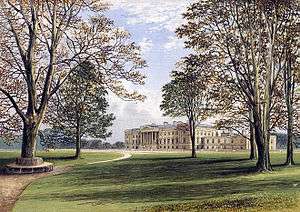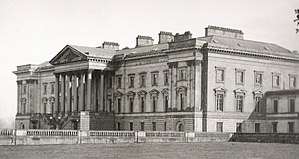Hamilton Palace
Hamilton Palace was a large country house located north-east of Hamilton in Lanarkshire, Scotland.[1] The former seat of the Dukes of Hamilton, it was built in 1695 and subsequently much enlarged. Widely acknowledged as having been one of the grandest houses in Britain, the palace was demolished in 1921, owing to the prohibitive cost of upkeep and the subsidence caused by the nearby mine at Bothwellhaugh.

The Palace

Built on the site of a 13th-century tower house, the south front of Hamilton Palace was erected in 1695 in the Palladian style, with a huge Corinthian pedimented frontispiece, by architect James Smith for William, 3rd Duke of Hamilton and his wife Duchess Anne. A new North Front had been planned by the fifth Duke in the 1730s, and extensive plans were prepared by William Adam. The external plans were never executed, but Adam did redesign several important staterooms, with stucco work by Clayton.[2] However, the Duke's early death and the significant costs involved postponed further major work, although modifications and additions continued during the next century, including the purchase or exchange of land surrounding the palace, enabling extensive landscaping to take place.[3]
The tenth Duke, who succeeded in 1819, began a wave of total refurbishment, using the seemingly limitless wealth that the family derived from their ownership of the Lanarkshire coalfields. This refurbishment included heraldic carvings in the main pediment over the entrance, carved by John Greenshields in 1822.[4] The north front itself was finally completed 1842 by architect David Hamilton using Adam's original plans as a structure. Carving was by the 16-year-old Patric Park.[5] The north front was 265 feet (81 m) long and 60 feet (18 m) high, adorned with a Corinthian portico of monolithic columns 25 feet (7.6 m) high. The state rooms, which included extensive stucco-work, were by Smith and Adam. These held much fine furniture and by the mid-19th century housed one of the best private collections of paintings in Scotland, including works by Peter Paul Rubens (see below), Titian, Anthony van Dyck, and other masters - the largest portion coming from his wife Susan's inheritance of an existing huge collection from her father William Thomas Beckford. A sumptuous chimneypiece by William Morgan adorned the Dining Room's fireplace.
According to Professor Tait in Burlington Magazine July 1983 the duke also sought alternative designs for the 1840s reconstruction by Charles Percier, Pierre François Léonard Fontaine and Giacomo Quarenghi.
Châtelherault

Hamilton Palace stood at the centre of extensive parklands which, as the main axis, had a great north–south tree-lined avenue over three miles (5 km) in length. The layout was later developed, most notably by William Adam, who introduced Châtelherault banqueting house/hunting lodge into the south avenue in the High Parks where it commanded a broad vista northwards across the Low Parks. Adam also added a very grand dog kennels at the same time to hold dogs for the hunts.
Decline and demolition
The demise of Hamilton Palace was the result of various factors: large and ostentatious houses had fallen from fashion; the cost of upkeep was prohibitive; and nearby coal mines resulted in dangerous subsidence as the coal beneath was removed. The decline began in 1882 when William, the twelfth Duke, sold off art to raise funds. After the thirteenth Duke lent his home for use as a naval hospital during World War I, the state of the palace was one of severe neglect necessitating vast sums for restoration.
It was returned from hospital use in 1919, but by this time the Duke preferred the smaller and more homely Dungavel. At this time the magazine Country Life featured a number of articles on the palace and a quantity of photographs were taken to accompany the series. As such they represent an invaluable record of the house before the massive sale of contents and fittings, and its demolition in 1921.[6]
The Rubens painting of "Daniel in the Lion's Den" is now in The National Gallery of Art, Washington D.C.[3]
The site today
The site of the palace is now occupied by the Hamilton Palace Sports Grounds. Most of the palace grounds were incorporated into Strathclyde Country Park. When the park was being constructed in 1974, vaulted cellars were discovered which may have belonged to the original house. However, these were not excavated but instead infilled with rubble.
Several metres of wrought iron railing from the palace grounds can be seen outside Hamilton College. There is a misconception that the railings were installed upside down but this is not actually the case. Some of the fittings, and photographs of the interior, can be viewed in the Low Parks Museum (the old Palace Coachhouse) in Hamilton.
The dining room from Hamilton Palace is on view at the Museum of Fine Arts, Boston, in the European period rooms, where it remains the only extant, assembled room from the Palace.
The sandstone bungalows on the south side of the A74, Carlisle Road, leaving Hamilton in the direction of Ferniegair and Larkhall are reputed to have been built from stone salvaged from the palace.
The remains of the tree-lined avenue that linked the palace to Chatelherault hunting lodge can still be seen. These give the visitor a good indication, particularly from Chatelherault Country Park, of where the palace stood. A David Lloyd health club, municipal sports facilities and an Asda superstore now stand on the site of the original palace.
Hamilton Mausoleum still stands and tours can be booked at the nearby Hamilton Museum. Tours are available on the first Sunday of each month between February and November.
Some of the stonework was used to build other buildings throughout Scotland, such as the WW1 Memorial Kirk at Bangour Village Hospital [7]
References
- Hamilton's royal past, South Lanarkshire Council
- Gow, Ian (2006). Scotland's Lost Houses. Aurum Press. ISBN 1845130510.
- Walker, Gavin (1977). Hamilton Palace: A photographic record. Hamilton District Libraries. ISBN 0950198323.
- http://www.glasgowsculpture.com/pg_biography.php?sub=greenshields_j
- Dictionary of British Sculptors 1660-1881, Rupert Gunnis
- Avray Tipping, H. (1919) "Hamilton Palace", Country Life
- https://www.westlothian.gov.uk/media/2592/Conservation-area-Bangour-Village-Hospital/pdf/BVH2014update.pdf
External links
- Hamilton Palace: A Virtual Reconstruction - A website developed by the Royal Commission on the Ancient and Historical Monuments of Scotland (RCAHMS) with maps, photographs, and virtual reconstructions of the palace itself.
- Hamilton Palace entry from The DiCamillo Companion to British & Irish Country Houses
- Hamilton Palace at Gazetteer for Scotland
- The Rise and Fall of Hamilton Palace at National Museums Scotland
.jpg)